I Analyzed 5 Startup-Friendly Mobile App User Acquisitions: Here’s What I Discovered (With Product Manager’s Insights)

With over 8.93 million apps available in 2024, the app marketplace is more competitive than ever. Acquiring new users isn’t just challenging—it’s costly. Average user acquisition costs have continued to rise, with the cost per install (CPI) for mobile apps in North America reaching $5.28 in 2024. For app startups with a shoestring budget, this can feel overwhelming.
Drawing from our experience scaling apps from zero to millions, we’ve developed smart, cost-effective customer acquisition strategies that help startups grow without overspending.
In this article, I’ll share proven mobile user acquisition strategies—ranging from free tactics to affordable paid options—that have worked wonders for our startup partners.
You’re also in for a treat because I had a chance to interview one of our product managers, Brian Wong, and shared his insights about these strategies.
What are the app user acquisition strategies for startups
- Optimize app store pages for better visibility
- Implement best SEO practices to rank on search engines
- Use social media channels to build credibility and user engagement
- Map out a reasonable budget for paid user acquisition for diversification
- Consider a hybrid and omnichannel approach
** BONUS * What mobile app metrics startups should track?
You may wonder what a mobile app user acquisition is if this is the first time you have encountered this term. It’s attracting and converting users to download and use a mobile app. The goal is to drive more traffic to your app and convert that traffic into users. You can implement free, paid, or a combination of paid and free strategies depending on your needs.
Free strategies involve organic methods and do not require direct advertising spend or other paid efforts to attract users.
Let’s look at each one, from zero investment to paid efforts—plus insights from our product manager and practical ways to do them.
1. Optimize app store pages for better visibility
🎯 Summary: Just as SEO helps websites rank higher in search results, App Store Optimization (ASO) is essential for mobile apps to boost visibility and downloads through strategic keyword usage, compelling visuals, positive reviews, and standout branding across app stores.
App store optimization (ASO) is a powerful way to boost user acquisition for your app. Like search engine optimization (SEO) for websites, ASO helps mobile app developers rank higher on the Apple App Store and Google Play Store search results pages (SERPs).
Higher rankings on app store results pages mean better chances of app downloads, directly impacting your growth. The United States is projected to outpace global trends, with consumer spending across both app stores reaching $86 billion in 2026. It’s clear that a well-optimized app page can drive substantial results and land you new mobile app users.
Many apps have very similar names in the app stores. Being able to stand out and create a more distinct app upfront, like unique descriptions, a good header, or a good title, will set you apart from competitors with the same name. So, by optimizing your app store page, you can even appear on the featured lists for apps.

Brian Wong
Product Manager
How to optimize your app store pages
Here’s how Duolingo, the popular language app, does it:
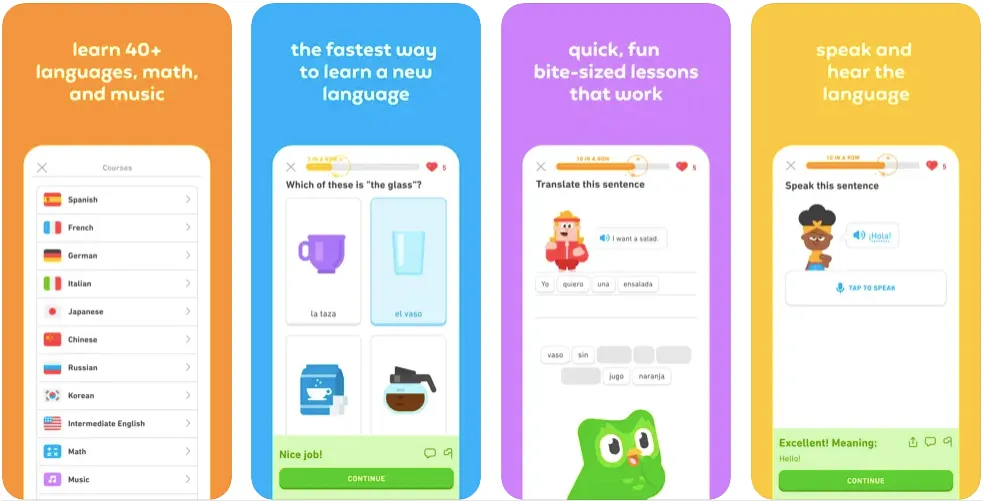
Source: Apple App Store
- ✅ Make your title keyword rich and descriptive. This means using the right keywords so that your app shows up when potential customers search for something related to your product or service. Tools like Google Keyword Planner, App Store Connect (for iOS), or Google Play Console (for Android) can help you discover valuable keywords.
- ✅ Add keyword-rich metadata to your description. Include an enticing description and high-quality screenshots so potential users can understand what your app is all about.
- ✅ Use high-quality visuals. Show off your app’s best features using clear, engaging screenshots and videos. According to the book, “Brain Rules,” we remember 10% of the information we heard three days earlier; we remember 65% if visuals were present.
- ✅ Strive for positive reviews and ratings. Research shows that 93% of consumers read online reviews before purchasing. Reviews and ratings also affect app rankings in the Apple App Store.
- ✅ Create an attractive and memorable app icon. Your app icon is the first thing users see, so it should stand out and reflect your app’s purpose. Make sure, too, that it meets the specifications and other requirements of the Google Play Store and Apple App Store.
2. Implement best SEO practices to rank on search engines
Summary: Website SEO remains crucial for app visibility, focusing on four key pillars: technical soundness (fast-loading, responsive design), user experience optimization, high-quality content creation, and organic link building—all working together to help your app appear in holistic search results across various platforms from app stores to tech blogs.
SEO (Search Engine Optimization) is about making your website or mobile app more visible in search results. Think of the internet as a massive library and search engines as librarians helping people find the right “book.”
By using smart techniques like clear titles, organized content, and relevant information, you increase your chances of being recommended.
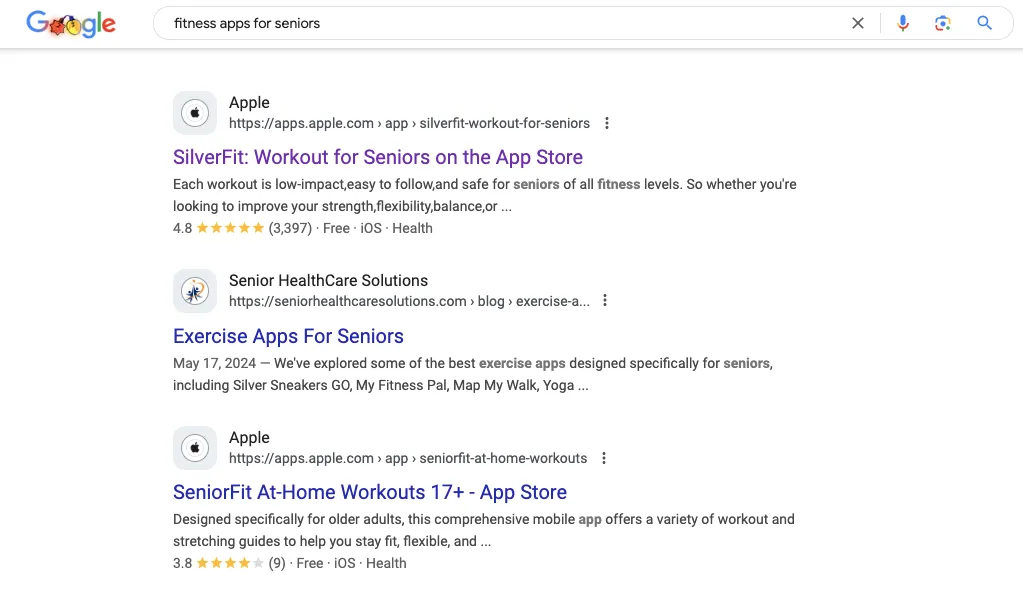
The challenge? Search engines constantly change their rules and keep their exact ranking methods secret. But some tried-and-true strategies always help you stand out.
📣 Be sure to check out our comprehensive guide on App Store Optimization best practices.
When you search for an app, like a game or a utility app, like a note-taking app, you will likely get some app results that Google will suggest. But it also depends a lot on the niche or the type of market you’re in. So, typically, with SEO strategies, you need to have a website or a landing page to acquire traffic and grow your SEO. For user acquisitions, it’s not impossible. It’s just tougher. It’s just a little bit tougher compared to other strategies. If you want a long-term approach, this is a good option.

Brian Wong
Product Manager
How to implement SEO like a pro
When you search for a free writing app for students, you will see a mix of search results from different touch points like app stores, tech blogs, Reddit forums, and others. This means that search engines like Google are becoming more holistic in providing user options that match their search intent.
Here’s how you get to kick things off and get your app visible on search results:
- ✅ Make sure your website is technically sound. This means having a crash-free, responsive design that scales to fit any screen size. Search engines favor websites that load quickly and are free of glitches since they are easier to crawl.
- ✅ Design a rich user experience. Search engines no longer rank sites based solely on keywords. To improve visibility in search results, design your site to meet your audience’s search intent. This means ensuring all elements, from navigation and headers to buttons and content structure, are utilized effectively to create a frictionless experience.
- ✅ Focus on creating high-quality content. Avoid stuffing keywords into your content just for its sake. Remember, all search engines aim to provide users with the best answers to their questions. Creating high-quality pieces will help users find your content and increase organic traffic.
- ✅ Don’t forget about link building. Link building is one of the most important ranking factors for mobile search, so reach out to other websites in your industry and try to guest blog or get featured on their site.
3. Use social media channels to build credibility and user engagement
Summary: Social media reaches over 5 billion people online, making it a powerful tool for app promotion. It enables direct user engagement, real-time feedback, and community building through strategic content creation, visual storytelling, smart hashtag usage, consistent posting, and engaging promotions like Grill’d’s successful combination of clever copy and compelling deals.
Social media is your secret weapon for app promotion. With over 5 billion people online, according to Viralyft, you’ve got a massive audience at your fingertips. But it’s not just about reach—it’s about connection. These platforms let you talk directly to your users, get real-time feedback, and build a community that’s genuinely excited about your app.
Imagine creating a space where users aren’t just downloading your app, but feeling like they’re part of something bigger. That’s the power of social media marketing.
Social media is probably the most powerful tool at the moment in acquiring app users and has the potential to help you engage with millions of users. I highly recommend this strategy—it’s low cost, and efficient. All you need is time and creativity, and you’ll be able to launch successful campaigns practically free.

Brian Wong
Product Manager
How to promote your app on social media
Your creativity is your limit when you embrace social media to amplify your reach and acquire new app users. There are many ways to do so. Below are some effective ways to get started:
1. Feature UGC to strengthen social proofing
User-generated content (UGC)—reviews, video testimonials, or photos from actual app users—is a powerful marketing tool that builds trust and community. With 90% of customers trusting UGC instead of traditional ads, it offers authenticity that paid advertising cannot match.
Speaking of user-generated content, a clever way to build momentum on this is crowdfunding your mobile app like how Good Empire’s André did on Birchal.

Their compelling concept and Appetiser prototype design attracted over a thousand investors. Armed with just a vision and a prototype, they successfully raised more than $1 million before any development work began.
2. Partner with influencers to tap a larger audience
I was on the fence about including influencer marketing after covering community and user-generated content, but it’s definitely worth mentioning. While it’s a paid acquisition method, it still fits within social media strategies.
You can partner with social media influencers to tap into pre-built, engaged communities that trust their recommendations.
But the key is authenticity.
When influencers genuinely connect with your app’s value proposition, their endorsement feels like a trusted friend’s recommendation rather than traditional paid advertising. Data shows that 78% of users report purchasing products after seeing them on TikTok, where content tends to be more organic and creator-driven.
If you’re wondering how much it costs to work with influencers, particularly on Instagram pricing packages, here are the rates I found:
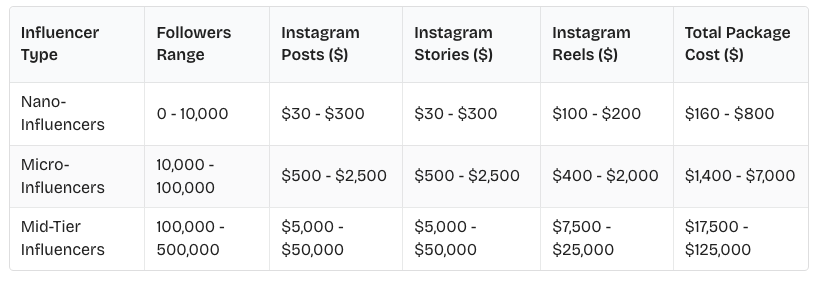
Source: Business of Apps
This approach, however, needs a huge budget. If you’re just starting to get new app users, here’s what our product manager has to say:
Influencer marketing is not exactly easy. To be honest, if you’re just starting, the chances of acquiring influencers are quite low. So first, you need to filter and vet through the influencers, assess whether they have good engagement with their community, and evaluate how they plan on referring your app to them. If it’s done properly, then yes, it is possible, but usually, partnering with influencers can be quite expensive.

Brian Wong
Product Manager
3. Invite loyal customers to refer your app using WOM
Much research has found word-of-mouth (WOM) marketing to be the most effective way of promoting services or products, including mobile apps.
Have a look at the following data:
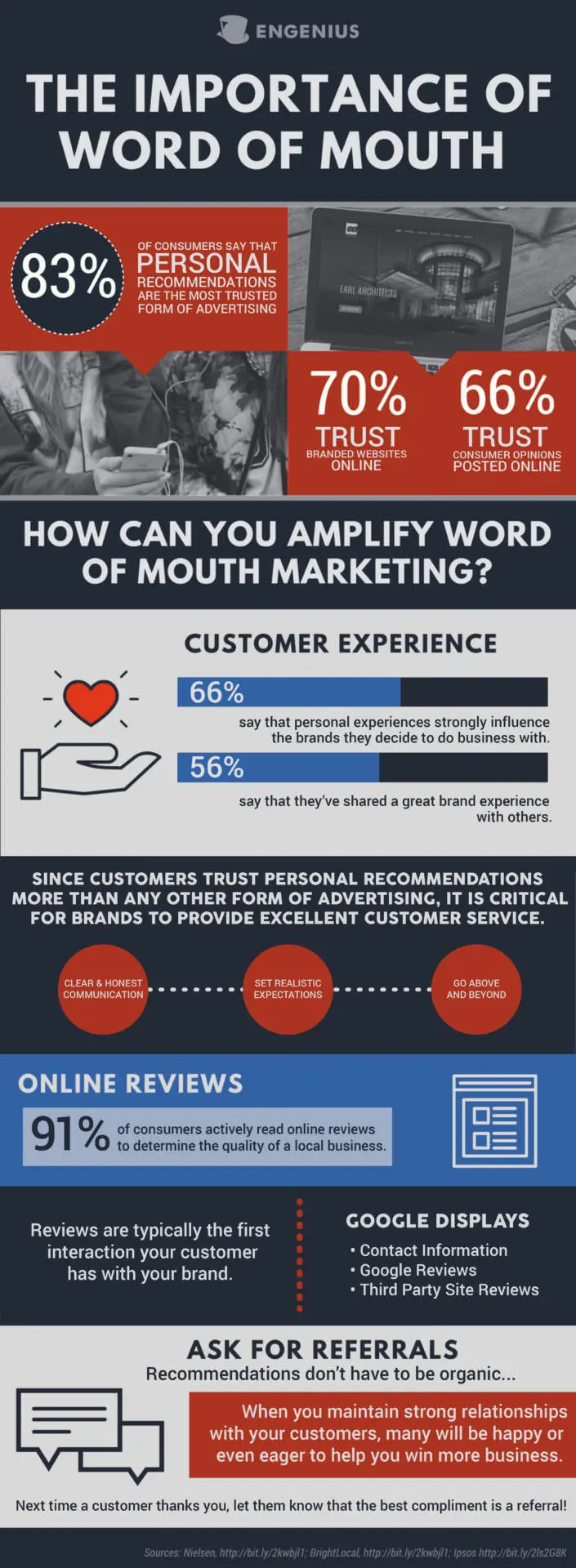
Source: Engenius
Most of all, visuals are your best friend. People scroll past text, but they stop for eye-catching images and videos. Go for high-quality, brand-aligned visuals and impactful video marketing strategies that grab attention fast.
Referrals and word of mouth—these could work. If you’re using a fanbase approach or you have an existing community like Chontel Duncan, a fitness influencer with millions of followers, conversion and user acquisition will likely be a lot cheaper and faster. So, if your app makes it easier for people to refer to others and share with others, and they get some benefits from it, then yes, I highly recommend it. This is still part of social media marketing initiatives.

Brian Wong
Product Manager
Indeed, organic methods are essential for long-term sustainability and success, but this doesn’t mean you should dismiss the idea of integrating paid strategies into your user acquisition master plan.
With how complex the user’s journey has evolved, it just makes sense to explore other types of strategies.

Source: LogRocket
In our experience consulting for app businesses, the most advantageous move often combines free and paid models. Now, just because a method is paid, it doesn’t mean it has to cost you a fortune. You can acquire more users without overshooting your budget.
📣 For more valuable insights for promoting your app, check out our article on the 7 Biggest Mobile Marketing Trends That Will Continue in 2023.
4. Map out a reasonable budget for paid user acquisition for diversification
Summary: Paid User Acquisition (UA) Networks help app developers run targeted ads across multiple channels. Over half (56%) of developers now focus on video ads. To succeed, choose networks that match your audience, provide clear analytics, flexible ad formats, and fair pricing.
Paid user acquisition involves investing financial resources to attract and convert new users to your mobile application. This strategy involves using different advertising channels and platforms to increase app visibility, drive installs, and grow your user base.
Paid user acquisition is a crucial component of many app marketing strategies. Thus, it complements organic growth efforts and allows scalable, targeted user growth.
There are three ways to do this strategy, so here’s an overview:
| Subcategory | Definition | Key Features |
|---|---|---|
| App store advertising platforms | Advertising directly within app stores like Apple’s App Store or Google Play Store |
|
| Paid user acquisition networks | Advertising across a broad range of channels outside of app stores |
|
| In-app advertising | Placing ads within other mobile applications to attract new users |
|
1. Use app store advertising platforms to amplify exposure
Summary: Get your app in front of eager downloaders by using Apple Search Ads and Google Ads to place your app exactly where they’re already searching. These platforms are cost-efficient since you only pay when users engage, plus you can target different audiences—iOS users through keyword-focused Apple Search Ads or Android’s diverse user base through Google’s behavior-based targeting.
While complementing app store optimization, paid app store advertising offers a distinct advantage: premium visibility to users already in a download mindset.
App store advertising involves placing paid ads within the app store environment. These ads appear prominently in search results, category pages, or as featured placements, targeting users actively browsing or searching for apps.
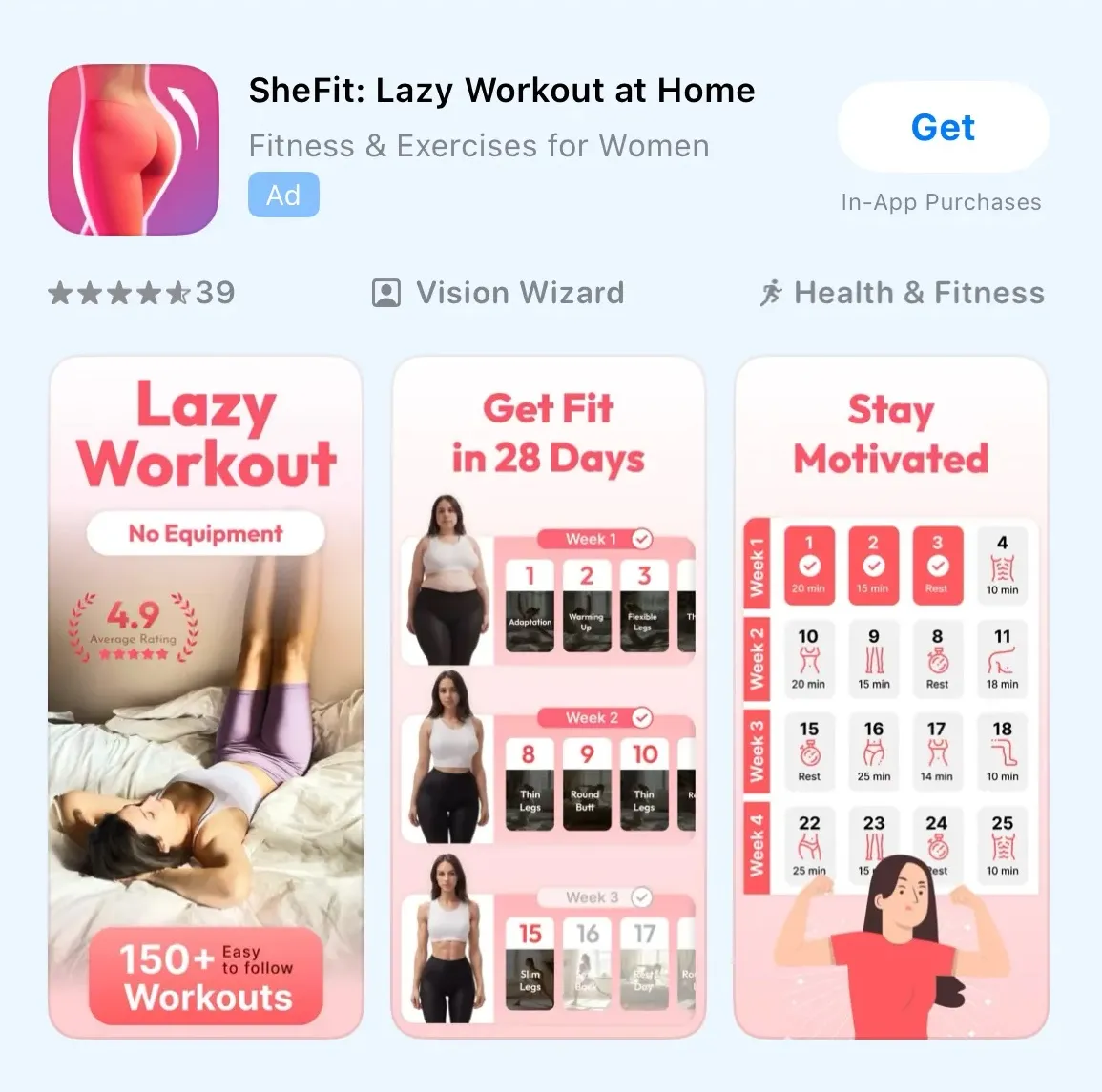
Source: Apple App Store
The two major platforms—Apple Search Ads and Google Ads—operate on a cost-efficient model where you only pay for actual engagement in a cost-per-click (CPC) or cost-per-impression (CPM) structure. To maximize your return on investment, it’s crucial to understand and leverage each platform’s unique strengths to reach your target users.
How do Apple Search Ads work on mobile app advertising?
Apple Search Ads work directly with the App Store, using iOS users’ search habits to show relevant ads. It focuses on matching keywords to what users are looking for, so your ad reaches people actively searching for apps like yours.
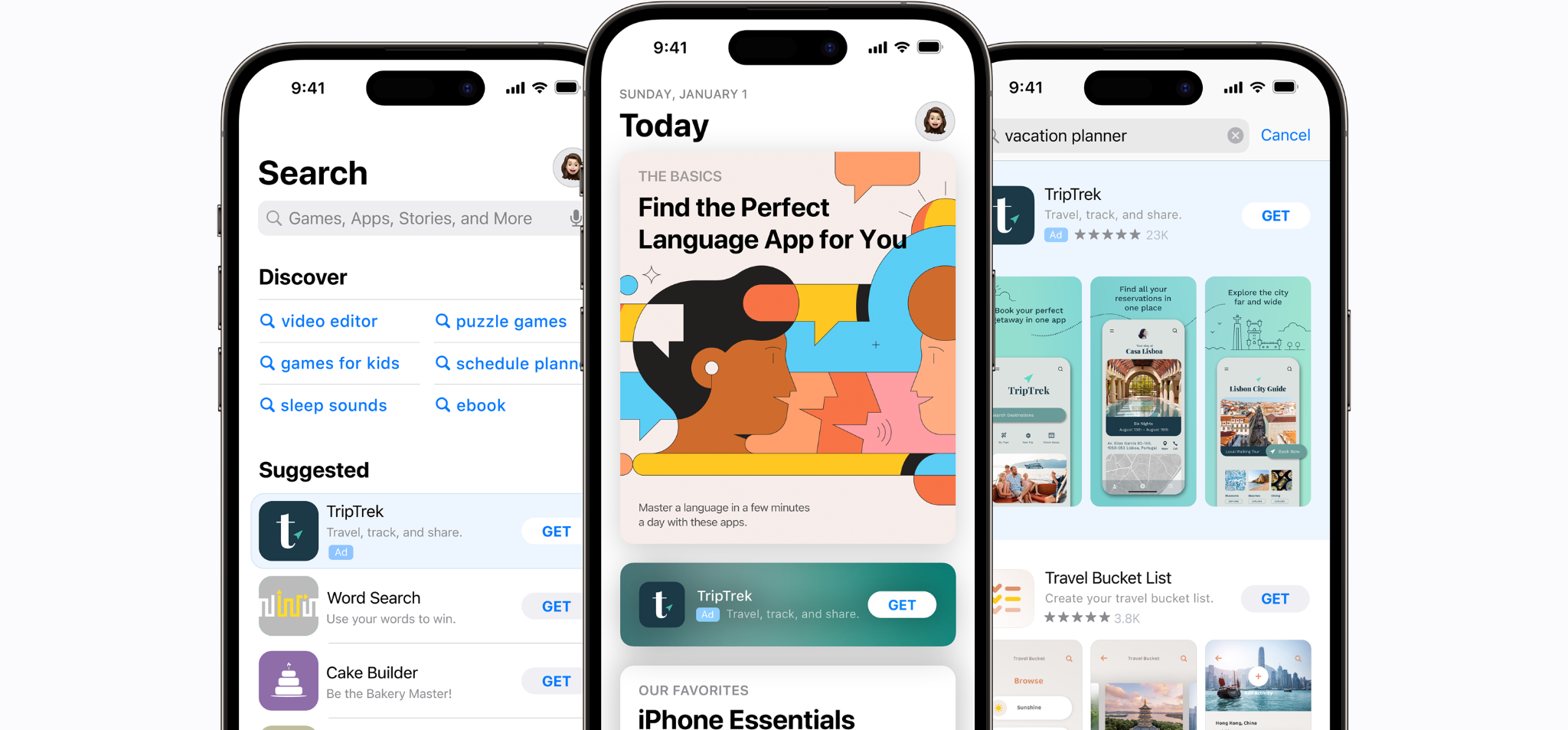
Source: Apple App Store
How do Google Ads work on mobile app advertising?
On the other hand, Google Ads targets Android users, giving advertisers access to a large and diverse audience. It uses demographic and behavioral targeting to customize ads, helping you reach users based on their interests, preferences, and app usage.
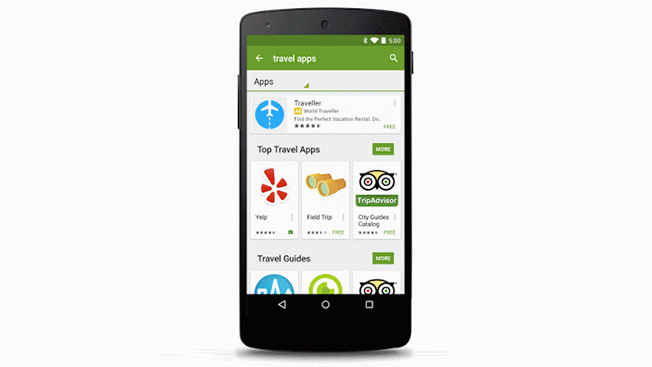
Source: Google Play
How to advertise effectively on the app stores
- Optimize your app store listing. Conduct thorough keyword research, optimize app titles and subtitles, feature a compelling description, include high-quality screenshots and videos, and observe other best ASO practices.
- Create engaging ad creatives. Use clear images, captivating graphics, and a consistent visual theme. Also, craft compelling ad copy that communicates the value of your app.
- Conduct A/B testing. Test different variations of your ad campaign elements, such as visuals, ad copy, and calls to action. This helps you identify the most effective components.
- Monitor and adjust your campaigns. Regularly analyze the performance of your ad campaigns. Track metrics such as click-through rates, conversion rates, and cost per acquisition (more on this below).
2. Explore paid user acquisition (UA) networks for targeted ads
Summary: Paid User Acquisition (UA) Networks serve as specialized platforms that help app developers run ads to attract new users. They work like marketplaces, letting you manage and launch ad campaigns across multiple platforms all in one place.
What sets UA networks apart is their focused approach to mobile app promotion, offering sophisticated targeting capabilities and performance tracking. This ensures your advertising budget directly translates to quality user acquisition.
While these networks provide powerful tools for scaling your app’s user base, their effectiveness depends heavily on selecting the right network partner that aligns with your app’s audience and growth objectives.
How to choose the right user acquisition networks
- Choose a network that aligns with your target audience. Pick the ones that show proven success in reaching and converting users within your app’s target demographic. The network’s publisher portfolio should align with where your potential users spend their time.
- Opt for a network that provides robust performance tracking and analytics tools. You need granular data on user acquisition costs, conversion rates, and campaign performance to optimize your ROI effectively.
- Consider the ad formats and creative options offered by the network. Your ability to test and iterate different ad approaches can significantly impact campaign success. In 2024, 56% of app developers shifted their focus to using video formats for their campaigns, emphasizing the importance of creative flexibility.
- Evaluate the network’s pricing structure and transparency. Look for networks offering flexible spending options and straightforward pricing models that align with your growth strategy. This helps whether you’re testing the waters or scaling aggressively.
3. Leverage in-app advertising to find the right audience
Summary: In-app advertising lets you promote your app within other popular apps that share your target audience, offering a cost-effective approach at $3-10 per 1,000 views compared to $22+ for traditional advertising.
This strategy involves promoting your app within other popular apps that cater to a similar audience. You put up ads in other apps to get people interested in yours.
One great thing about this method is that it is cost-effective, meaning you can control how much money you spend based on how many people see or click on your ads. It’s also often cheaper than other traditional ways of advertising.
Reaching 1,000 people through online advertising typically costs from $3 to $10, while the average cost of reaching the same audience through traditional or offline advertising starts at $22 and can go higher.
Another exciting benefit of in-app advertising is that it gives you a lot of data. This data helps you see how well your ads are doing and understand what existing users are doing in your app. Having access to that information empowers you to make your ads better and get more people interested in your app.

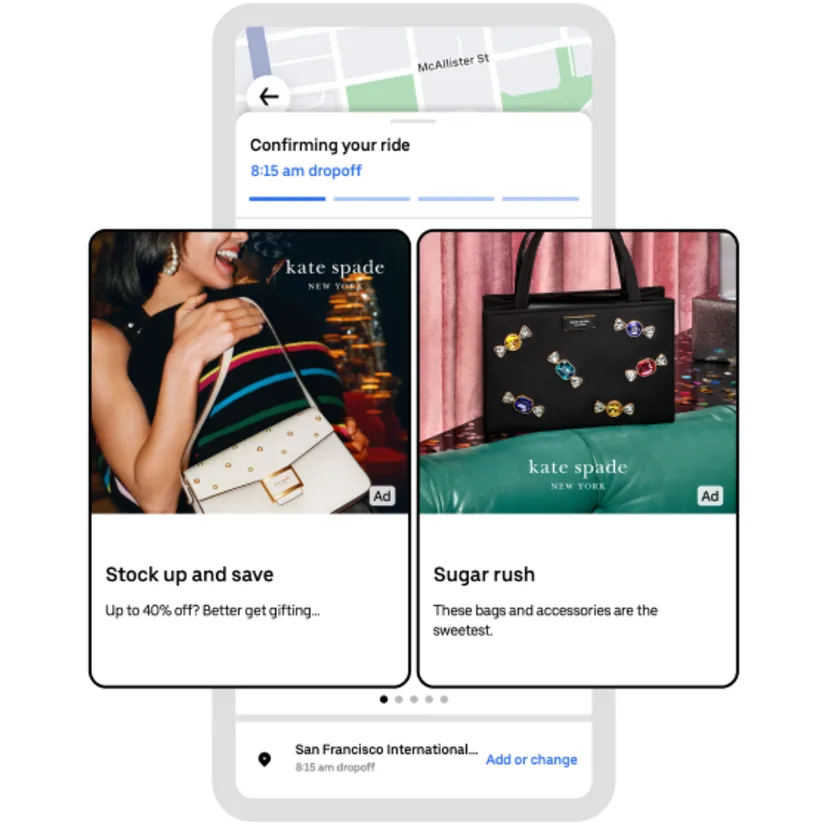
Source: Uber
One ad hosting app that executes this method well is Uber. The company offers advertising surfaces on both its ride-hailing and food service platforms. With visibility to customers’ data and in-app activity, Uber manages to feature targeting hyper-relevant ads.
How to execute in-app ads effectively
- ✅ Ensure precise targeting. Identify your target audience based on demographics, interests, and behavior. The more accurately you can target your ads to specific user groups, the higher the chances of attracting users genuinely interested in your app.
- ✅ Create eye-catching and engaging ad creatives. Whether it’s banners, interstitials, native ads, or videos, your visuals and content should stand out. Use clear and compelling language, high-quality images, and concise messages to capture users’ attention and convey the value of your app.
- ✅ Prioritize user experience. Ensure that your ads seamlessly integrate with the user experience of the hosting app. Users tend to receive non-intrusive and well-placed ads positively. Consider the mobile ad type, placement, timing, and frequency of your ads to enhance the overall user experience.
- ✅ Regularly analyze performance metrics and user data. Pay attention to click-through rates, conversion rates, and user engagement (more on this below). Use this information to refine your targeting parameters, adjust ad creatives, and allocate your budget effectively.
5. Consider a hybrid and omnichannel approach
Summary: Modern app marketing thrives on integrated strategies, as shown by innovative examples like Chess.com’s smart push notifications, IKEA Place’s augmented reality shopping, and Tokopedia’s multi-channel onboarding that boosted retention by 60%. The key is connecting with users through a mix of digital and physical touchpoints, using tools like location targeting and AR to create seamless experiences that drive engagement.
Modern app marketing demands an integrated approach across multiple touchpoints. With users engaging through an average of six channels before making decisions, a hybrid marketing strategy that blends online and offline platforms has become indispensable.
In fact, 73% of retail consumers now interact across multiple channels. While this data is related to online shopping, it shows that an omnichannel presence is beneficial and crucial for maximizing your app’s reach and user acquisition.
Chess.com exemplifies omnichannel excellence by orchestrating a seamless user experience across mobile, web, and email platforms. Their standout strategy centers on intelligent push notifications that don’t just alert—they engage.
Source: YouTube
When users receive a notification, they’re instantly transported to a pre-loaded game, eliminating friction and making app re-engagement irresistible. This smart integration between platforms has transformed casual players into dedicated users, proving that thoughtful omnichannel execution can significantly boost engagement and app retention rates.
I asked our product manager what he thinks of this approach.
You’ll be very successful with a lot of money when it comes to hybrid and omnichannel strategies. This is very expensive to run. There are different ways and channels, so users will see your app and products everywhere. It’s doable but not recommended unless you have a lot of money or have strikingly great connections that can do it for you.

Brian Wong
Product Manager
How can hybrid and omnichannel strategies be effective?
This multi-channel approach isn’t just about widening your reach. It’s about building resilience into your user acquisition strategy and optimizing your marketing spending across different platforms.
Here are some creative ways to do it:
- ✅ Location-based marketing. KFC demonstrates the power of location-based targeting in driving both physical and digital engagement. By strategically targeting busy families near their restaurants, they transformed casual passersby into active app users.
- ✅ Augmented reality bridging the physical and digital experience. IKEA Place redefined the furniture shopping experience by bringing showrooms directly into customers’ homes through augmented reality. This innovative approach doesn’t just let users visualize furniture—it eliminates the biggest barrier to online furniture shopping: uncertainty. The results speak volumes: users spend five minutes longer engaging with products than traditional catalog browsing, and the app has captured an impressive 370,000 monthly active users worldwide.
- ✅ Use omnichannel marketing for onboarding. Tokopedia’s strategic onboarding demonstrates omnichannel marketing at its finest. By guiding users through app features via coordinated push notifications, emails, and personalized offers, Indonesia’s largest marketplace created a seamless user journey from installation to purchase. The result? A dramatic 60% boost in user retention and 20% increase in first-time purchases.
In reality, successful app marketing requires a seamless blend of online and offline touchpoints, with users typically engaging across six different channels before making decisions.
Here’s a video of how IKEA does it using augmented reality.
Source: YouTube
On top of the user acquisition initiatives, you want to ensure you’re tracking the right metrics to have the correct data to understand how your audience responds to your campaigns.
What mobile app metrics startups should track?
Part of ensuring a successful mobile user acquisition strategy is keeping tabs on your app’s performance.
To make sound decisions, pay attention to the following key metrics:
| Metric | What You Need to Know |
|---|---|
| Cost per Acquisition (CPA) | The cost to acquire new users per channel. Calculate by dividing the total acquisition cost by the number of new installs. Essential for measuring marketing efficiency. |
| Engagement Rate | Tracks how users interact with your app through Daily Active Users (DAU), Monthly Active Users (MAU), and average session length/frequency. Shows user interest and app stickiness. |
| Churn Rate | The percentage of users who abandon your app in a given timeframe. Calculated by dividing total uninstalls by total installs at period start. Indicates user satisfaction and retention issues. |
| Total App Uninstalls | The total number of times users have deleted your app. Simple subtraction of current installations from initial installations. Helps identify major drop-off points. |
| Retention Rate | Measures how well you keep users over time. Can be calculated as aggregate (monthly active/total installs) or by cohort (retained users/initial installs in timeframe). Critical for long-term success. |
📱1. Cost per acquisition (CPA)
To gauge how effectively you’re able to acquire new mobile users, you must calculate your cost per acquisition (CPA) or how much you spend to acquire new users. Calculating CPA follows this straightforward formula:
- CPA = Total user acquisition cost per channel / Number of new app installs in a given timeframe
📱2. Engagement rate
This metric measures how often users interact with your mobile app. It indicates how interested users are in what your app has to offer. To gauge user engagement, you need to track the following:
- Daily Active Users (DAU) and Monthly Active Users (MAU): How many use your mobile app daily and monthly
- Average Session Length & Frequency: How often and long app users interact with your mobile app
📱3. Churn rate
App churn rate is the percentage of users who stop using your mobile app within a given period. This metric gives you insight into how good your app is in keeping users. Here’s the simplest way to calculate your app churn rate:
- Churn rate = Total app uninstalls on a specific timeframe / Total app installs at the start of the specified timeframe
📱4. Total app uninstalls
This metric reflects the cumulative number of times your application has been removed or deleted from users’ devices. It indicates a loss of active installations. The formula to calculate the total app uninstalls is straightforward:
- Total App Uninstalls = Initial Installations −Current Installations
📱5. Retention rate
App retention indicates users’ continued use of your mobile product or service. It reflects your mobile app’s ability to keep users interested over time. Calculating app retention can be done using any of the following formulas:
- Aggregate retention rate = Total monthly active users / Total app installs
- Retention rate for cohort = Total users retained at the end of a given timeframe / Total app installs at the start of a given timeframe
The key to a solid user acquisition strategy
When it comes to app marketing, user acquisition is an ongoing process that requires the perfect blend of strategy, split testing, and data. Therefore, the key to implementing an effective user acquisition strategy is consistency.
While some user acquisition hacks I’ve mentioned may be more effective than others, they all require ongoing effort and attention to produce results. So, don’t be discouraged if you don’t see positive impacts immediately.
Mobile app user acquisition is about time and investment especially if you’re just starting in the app business. It’s usually a slow race. It’s a marathon. It’s not something that you can just throw money at and then get results immediately. It takes a lot of time. Most importantly, you start building content in your social media accounts. You start creating content for your users. Whether on a website or social media, it’s best to start there first—whatever digital assets you have right now—before hiring digital marketers and agencies to create content creators.

Brian Wong
Product Manager
Continue to measure crucial mobile app metrics and pivot strategies accordingly. As long as you’re consistent with your efforts in mobile user acquisition strategy, you should start seeing a difference in your app’s popularity and engagement levels.
You may also check out an article written by one of our founders for a comprehensive, step-by-step guide to promoting your app before and after launch.
Ready to level up your mobile app business? Reach out to us, and let’s explore how we can enhance your success together and acquire users.

Jane Eslabra has 14+ years of experience producing content across traditional and digital platforms. She channels her strong passion for fostering tech startup growth through knowledge sharing.


